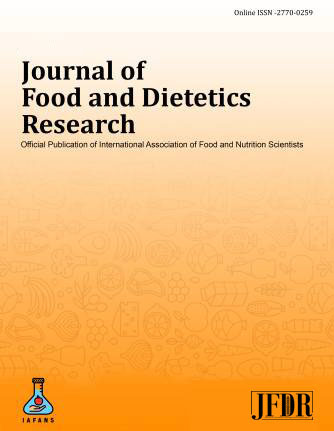Development And Evaluation Of Nutribite Crackers Using Lotus Root (Nelumbium Nelumbo)
DOI:
https://doi.org/10.48165/jfdr.2024.4.11Keywords:
Lotus root, Wheat flour, Maize flour, Healthy snack, Value addition, NutridenseAbstract
With increasing nutritional awareness among consumers, the value addition of snacks is gaining importance. The development and availability of value-added, nutridense snacks encourage consumers to make healthy snack choices. Value-added and nutridense snacks consumed by school-going children can contribute to a significant source of energy and nutrients. Lotus root is a less utilized vegetable containing various nutrients. It is a rich source of polyphenols, antioxidants, and dietary fiber. Lotus root is a versatile, culinary delicacy that can be cooked in different ways by stir-frying, boiling, braising, steaming, or deep-frying. This investigation was undertaken to develop a value-added, nutritious Nutribite Crackers, crispy textured and attractive lotus root-based snack for all age groups, especially pre-school and school children. Regular maize flour-based crackers were prepared and standardized as a control sample (MFC). Nutribite Crackers in three different variations (V-1, V-2, and V-3) were prepared using a combination of Lotus root, Maize flour, Wheat flour, Bajra flour, and Jowar flour. The developed crackers (Control: MFC and Variations: V-1, V-2, and V-3) were subjected to sensory evaluation, using a 9-point hedonic rating scale, to study the acceptability by 50 semi-trained panelists. Sensory evaluation results revealed that Nutribite Crackers prepared using Wheat flour, Maize flour, and Lotus root (V-1) were found to be most acceptable with total mean score of (52.02) out of (54), followed by (V-2) prepared using Jowar flour with a total mean score of (49.92) out of (54), then followed by (V-3) prepared using Bajra flour with total mean score of (47.84) out of (54). 100 g of best-rated Nutribite Crackers (V-1) has 545.85 kcal, 4.93 % crude protein, 20.37 % crude fat, 69.80 % carbohydrate, 1621.00 mg/kg potassium, 380.78 mg/kg calcium and 46.77 mg/kg iron. Control and all three variations showed a shelf life of more than 30 days under normal storage conditions. Lotus root incorporated Nutribite crackers (V-1) developed and standardized in this investigation serve as an ideal snack with several health-promoting nutrients for consumers.
Downloads
References
Hess, J. M., Jonnalagadda, S. S., & Slavin, J. L. (2016). What Is
a Snack, Why Do We Snack, and How Can We Choose
Better Snacks? A Review of the Definitions of Snacking,
Motivations to Snack, Contributions to Dietary Intake, and
Recommendations for Improvement. Advances in nutrition
(Bethesda, Md.), 7(3), 466–475.
Roy Nibedita. (August 11, 2021) Lotus roots, its culinary uses
and health benefits. Times of India. https://timesofindia.
indiatimes.com/life-style/food-news/lotus-roots-its-culinary-
uses-and-health-benefits/photostory/85211638.cms.
Longvah T, Ananthan R, Bhaskarachary K, Venkaiah K . (2017)
.Indian Food Composition Tables, National Institute
of Nutrition , ICMR , Department of Health research,
Ministry of Health and Family welfare, Government of
India, Hyderabad , 1-500
Kaur P, Purewal SS, Sandhu KS, Kaur M, Salar RK. ( 2019, March).
Millets: A cereal grain with potent antioxidants and
health benefits. Journal of Food Measurement and
Characterization. 15;13:793-806.
Ambati K, Sucharitha KV.( 2019, July) . Millets-review on nutritional
profiles and health benefits. International Journal of
Recent Scientific Research, 10(7):33943-8.
Dayakar Rao, B., Bhaskarachary, K., Arlene Christina, G. D.,
Sudha Devi, G., Vilas, A. T., & Tonapi, A. (2017). Nutritionaland health benefits of millets. ICAR_Indian Institute of
Millets Research (IIMR) Rajendranagar, Hyderabad, 112.
Dias-Martins, A. M., Pessanha, K. L. F., Pacheco, S., Rodrigues, J.
A. S., & Carvalho, C. W. P. (2018). Potential use of pearl millet
(Pennisetum glaucum (L.) R. Br.) in Brazil: Food security,
processing, health benefits and nutritional products. Food
research international (Ottawa, Ont.), 109, 175–186.
Prathyusha, N., Lakshmi, V. V., & Manasa, T. (2021). Review on
consumer awareness and health benefits about millets. The
Pharma innovation journal, 10(6), 777-785.
A Sruthi, PT Seeja, ER Aneena, Pathrose Berin and Mathew
Deepu (2019 April) .Insights into the composition of lotus
rhizome. Journal of Pharmacognosy and Phytochemistry.
(3), 3550-3555








